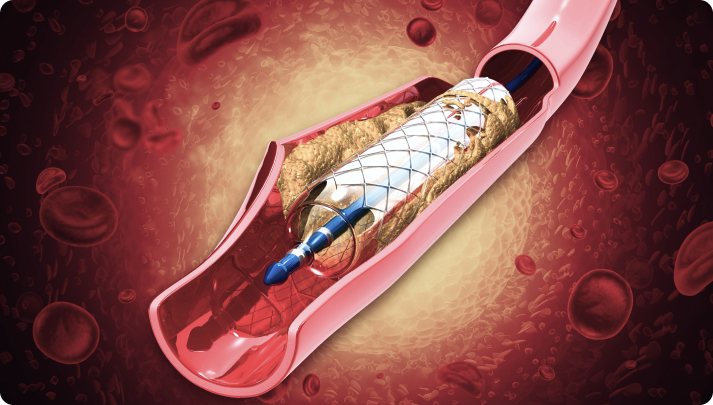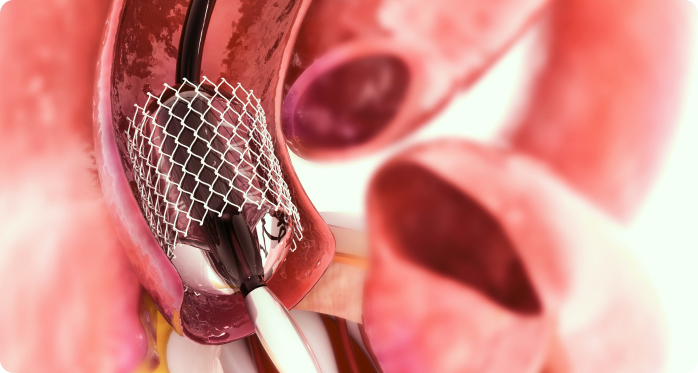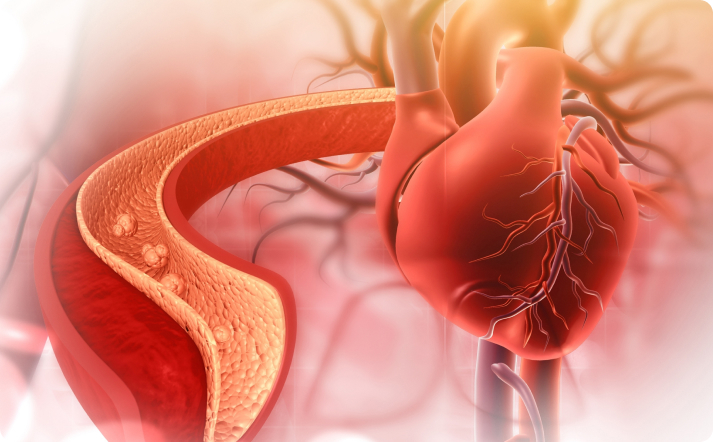Angioplasty in Singapore
Restoring Proper Blood Flow to the Heart with Angioplasty
The heart is a crucial organ that keeps us alive by beating 100,000 times a day and pumping up to
five litres of blood throughout our body through a complex network of blood vessels that measure
approximately 96,560 kilometres!
It is no surprise, then, that coronary artery disease—resulting in blocked coronary arteries (the
main blood vessels supplying the heart with a constant supply of blood)—is a dangerous condition.
Unblocking these arteries is crucial to one’s health and sometimes even survival itself.
In modern interventional cardiology, coronary angioplasty surgery is an effective method of widening
obstructed coronary arteries when an urgent situation calls for it.

What Is an Angioplasty & Heart Stent For?
Angioplasty, also known as percutaneous coronary intervention (or “balloon heart surgery”),
is a procedure done to open up clogged heart arteries.
This restores blood flow to the heart muscles without the need for open-heart surgery.
Usually, this is done in emergency situations, such as a heart attack, or if doctors
recommend it to their patients who are suspected to have heart disease.
Angioplasty treatment uses a balloon attached to a catheter, which is inserted through a
blood vessel and ultrasound-guided into the clogged coronary artery.
Once the catheter is properly placed, the balloon will be inflated to help widen the blocked blood vessel and improve
blood flow to the heart.
Aside from the coronary arteries, balloon angioplasty is also used to treat narrow or blocked arteries in other parts of
the body, such as the arms and legs (peripheral arteries) and the carotid arteries in the neck that supply blood to the
brain.
Today, cardiac catheterisation (angioplasty) typically involves the use of a stent. This short, expandable mesh tube is
placed into the newly opened part of the artery, preventing it from closing or narrowing again.
How Is a Stent Inserted?
Once the balloon is inflated, a stent will be inserted within the artery to expand and displace the
plaque towards the sides of the arterial wall. The doctor will
then gently retract the balloon and catheter, leaving the stent in place to keep the artery open and
maintain continuous blood flow to the heart muscle.
The number of stents implanted during a balloon angioplasty depends on the severity of the heart
disease and the location of blocked arteries. An individual may receive multiple stent placements,
but complications such as in-stent restenosis may occur.
Most stents are permanently attached inside the vessel and can last a lifetime, although some stents
may be dissolvable in the bloodstream for around
two years.
When Is an Angioplasty Used?
If the flow of the blood to the heart is obstructed due to a narrowed artery (caused by a buildup of
cholesterol or plaque), it may result in chest pain,
a warning sign to seek help immediately. In serious cases, a blood clot may form, or the obstructed
blood flow may worsen until the artery is completely blocked, resulting in a heart attack.
In such cases, a coronary angioplasty may be used to widen blocked or narrowed coronary arteries, so
that normal blood flow can be restored.
two years.
What Is an Angiography or Angiogram?
A coronary angiogram is a test used to determine if your coronary arteries are obstructed, where, and by how much. Knowing this will also allow your cardiologist to determine what kind of treatment you need.
- Will lifestyle and diet changes suffice?
- An angioplasty (with or without a stent?)
- A coronary artery bypass surgery?

What Happens During an Angiogram?
A catheter (a tiny tube) will be inserted through an artery in the groin or arm and gently threaded until it reaches a coronary artery.
A contrast dye will be delivered into the bloodstream through the catheter to make the arteries more visible on the X-ray image.
By analysing the X-ray images, your cardiologist can identify any problems in your coronary arteries.
How Does an Angioplasty Work?
A coronary angioplasty opens up blocked or narrowed arteries and restores normal blood flow to the heart. It is not a major surgery and causes minimal discomfort and downtime.
- A catheter (a tiny tube) will be inserted through an artery in the groin or arm and gently threaded until it reaches a coronary artery.
- A thin wire is threaded through the catheter to reach the point of obstruction in the coronary artery. A small balloon is attached to this wire.
- The balloon is inflated to widen the obstructed artery, pushing the plaque to the sides of the arterial walls and allowing normal blood flow to resume.
- In many cases, a stent—sometimes dissolvable—is opened as the balloon is inflated and locked in that position to ensure the artery stays open.
- The balloon and catheter are gently removed, and normal blood flow will continue.
What Happens After an Angioplasty?
Angioplasty usually takes 30 minutes to two hours to complete, depending on the complexity. Patients will need to be monitored after the procedure. This allows the medical team to watch for potential complications like bleeding, blood clots, or heart rhythm disturbances, and address them immediately. If there are no complications, patients will be discharged. Most patients can return to work within one to two weeks. However, they should refrain from heavy lifting and strenuous exercise for at least 30 days.
Is the Angioplasty Suitable for Anyone With Narrowed Arteries?
Though the angioplasty procedure has significantly improved the process of treating artery blockages with greatly reduced invasiveness (compared to open-heart bypass surgery) and its corresponding reduced discomfort and risks, it might not be the first line of treatment nor suitable for all.
When to Consider Coronary Angioplasty?
Coronary angioplasty is commonly recommended for individuals with blockages or narrowing coronary
arteries (atherosclerosis) or those experiencing symptoms of stable angina (chest pain). This
procedure is also recommended as an emergency treatment for a heart attack caused by excessive
clogging
of the arterial vessels.
Furthermore, doctors may perform an angioplasty when a blocked or narrowed artery fails to improve
with prescribed medications or dietary and exercise modifications.


Possible Options Before Angioplasty: Lifestyle & Diet Changes
In cases where the narrowing is not severe, your cardiologist may recommend a change in lifestyle and diet first to see if the condition improves. These may include:
- Regular exercise
- Quitting smoking and drinking
- Weight loss if you are overweight
- Controlling cholesterol levels
- A healthy diet (less sugary and fatty foods)
When Is One Not Suitable for an Angioplasty?
- Usually, when the patient has diabetes, which frequently causes circulation problems and damages blood vessels.
- When the patient has weak cardiac muscle
- When the patient has multiple diseased or blocked blood vessels – In this case, coronary artery bypass surgery may be more suitable instead.
What Are Possible Risks of Angioplasty?
Coronary angioplasty is a safe and well-tolerated treatment for blocked arteries. But, as with any medical intervention, they carry certain risks, which include:
- Damaged Artery – In some cases, the treated artery may become damaged, or may narrow again over time.
- Blood Clots – A blood clot may form at the site of a stent placement, which can obstruct blood flow and cause a stroke or heart attack.
- Bleeding or Infection – Minor bleeding, bruising, or infection may occur at the site where the catheter was inserted.
The risks and benefits of angioplasty will be discussed beforehand so that you are able to make a well-informed decision.
Life After an Angioplasty
Perhaps the most important thing to note is: no matter how effective an angioplasty is, it is not a
permanent treatment for coronary artery disease!
If the patient does not adopt an active and healthy lifestyle after angioplasty or fails to take their
prescribed medicines as instructed, plaque may start building up all over again, leading to the
narrowing of the coronary arteries.
Hence, while the angioplasty may give patients a new lease in life, they must follow up regularly with
their cardiologist, take their medicines as prescribed, and lead a healthy lifestyle to prevent the same
condition from recurring.
Frequently Asked Questions
What's the difference between an angioplasty and angiography?
An angiography is a test that uses an X-ray and contrast dye to generate real-time images ofz the heart's blood vessels and confirm the presence of coronary artery disease or blockages. In contrast, angioplasty is a treatment procedure that uses a balloon-tipped catheter and stent to widen blocked or narrowed arteries.
Are there alternatives to angioplasty?
In cases of severe arterial blockages, a coronary artery bypass surgery (CABG) is a possible surgical alternative to angioplasty. This procedure involves using the patient’s own healthy blood vessels from different body areas, such as the leg or chest. These grafts form another route or bypass a segment of the diseased artery to help restore the flow of oxygen-rich blood to the heart muscle.
Our Insurance Partners
To keep our services accessible and convenient to our patients, we accept most major insurances
and can assist with the claims process.
We encourage you to call our clinic so we can review your coverage and assist you accordingly.












